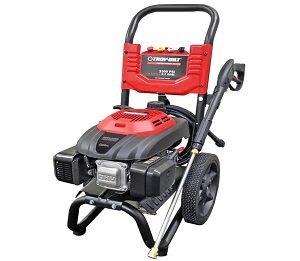 Troy Bilt has been making the patio and garden machinery for over 60 years and is well known for its lawn tiller and mowers. Troy Bilt is also the largest producer of gas-powered pressure washers with variable pressure and size, with a fuel capacity of 0.25 gallons to 0.4 gallons. The process to start the Troy Bilt pressure washer is pretty the same as starting their other equipment but with some extra steps. If you have just bought their equipment and want to know about the procedure to start it, this article is for you.
Troy Bilt has been making the patio and garden machinery for over 60 years and is well known for its lawn tiller and mowers. Troy Bilt is also the largest producer of gas-powered pressure washers with variable pressure and size, with a fuel capacity of 0.25 gallons to 0.4 gallons. The process to start the Troy Bilt pressure washer is pretty the same as starting their other equipment but with some extra steps. If you have just bought their equipment and want to know about the procedure to start it, this article is for you.
Steps To Start Troy Bilt Pressure Washer
To start the pressure washer first, you would have to prepare it and make the necessary connections. After that, there are some steps to create it. These are the steps to start the pressure washer:
- Remove the oil cap from the top of the engine crankcase. Pour the engine oil into the crankcase enough to fill it till the reference point. Now place the lid back on it and tighten.
- Now, fill the gasoline in the fuel tank. Remove the cap, serve it to the right amount, and tighten the lid.
- Place the pressure washer on the leveled surface and near the suitable water source. The suitable water source in that care is the one that can supply the water to the pressure washer at a rate of 3.3 gallons per minute or more with a pressure of more than 20 psi. Do not try to siphon the water supply.
- Connect one end of the garden hose to the water supply.
- Attach the garden hose to the water inlet into the pressure washer.
- Make sure that all the connections are tight and secured.
- Now turn the water supply on and let the water flow through the pressure washer. This will remove any trap air or debris.
- Now, connect the pressure nozzle at the end of the spray wand. Make sure to connect the suitable nozzle at the end of the spray wand.
- Now, engage the trigger lock that is mounted on the spray wand. This prevents the trigger from moving. The trigger lock is directly behind the trigger and is a safety feature used to ensure the water does not come out once the engine is started.
- Turn the throttle to the closed position. Now press and discharge the primer bulb repeatedly on the engine six to ten times to inject sufficient fuel into the fuel line.
- Turn the engine’s choke to the choke position and if the engine is already warm, turn the choke lever to the Run position.
- Now position yourself correctly to start the engine. Now pull the string slowly until you feel some resistance. Now remove the line rapidly to start the engine. The machine should begin at about ten pulls, and if it does not, wait for some time and start counting again.
Safety Precaution
Safety is the priority, and at the start of the pressure, you should take some necessary safety measures to prevent any damage caused by malfunctioning or any unpredicted incidents. These are the safety measure that you should follow:
- Wear PPE (personal protective equipment)
- Do not pull the starter string without relieving the pressure built at the pressure wand.
- Always use the pressure washer on the smooth surface.
- Firmly grip the pressure washer with both hands to avoid any back pressure.
- Do not use the pressure washer in an unstable position on the ladder.
- Make sure that all the connections are tight before starting the pressure washer.
- Do not run the pressure washer for too long when the spray wand is not discharging.
Common Starting Problems
If the troy bilt pressure washer is not starting, there would be several reasons behind it. These are the checks to perform if the pressure washer is not starting.
- Check that all the connections are in place.
- Check to see if there are some wire cuts or some loose wires.
- Check the fuel in the tank. If it looks empty, fill it.
- Check the oil in the crankcase. Some engines have safety mechanisms to prevent them from starting if there is not enough oil in the crankcase.
- Check that the spark plug, air filter, and oil filter are in place.
- Check to see if there is any fuel stall in the tank.
- Check the fuel line for any blockage.
- 10 Best Budget Pressure Washer 2023 – Reviews & Buyer’s Guide - December 7, 2022
- 10 Best Pressure Washer for Cars Wash Reviews [2023] - December 6, 2022
- 10 Best Commercial Pressure Washer 2023 –Buyer’s Guide - December 5, 2022
